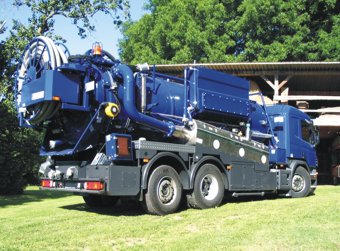
Nova Scotia's new approaches to treating wastewater
Printer Friendly Page
By Robert Anderson
 |
PHOTO: COURTESY OF NOVA SCOTIA DEPT. OF ENVIRONMENT & LABOUR |
In Nova Scotia, the coastal region's history is like that of many long-settled areas on the Gulf of Maine. For generations, human waste was pumped out into the ocean and so long as the tide took it away twice a day, no one saw any cause for concern.
Fortunately that mentality has been changing. More than everbefore, it is acknowledged that the shoreline where fresh water meets salty ocean tides is a ribbon of bio-complexity, and that ribbon doesn't end at the offshore boundary between Nova Scotia and other provinces and states.
The province is working on many initiatives to predict and minimize the effects of human development and climate change on coastal water resources, particularly in those rural coastal communities that are so often serviced by on-site septic systems. More than 150,000 septic tanks service 45 percent of the province. Because more people want spacious building lots for new homes, Nova Scotia Environmental Labour (NSEL) reviews more than 5,000 applications for new septic systems each year.
In addition to environmental awareness, good relationships between industry and environmental regulators are also a sign of the times. Today, industry leaders and government regulators in Nova Scotia work together to improve on-site systems and protect the environment. Partnerships and innovation are leading to a number of exciting new options for better management of wastewater.
Regular septic pumping
One such initiative is a municipal pumping program that coordinates the pumping of septic tanks in an entire neighbourhood at once on a regular rotating schedule, much like curbside solid waste collection. Several municipalities in Nova Scotia, including the District of Chester on the South Shore, have all shown interest in this idea. In the municipality of Chelsea, Quebec, the program is already a success. Homeowners pay their municipal council for a portion of the value of the service each year along with their property tax. In return, the septic systems in their neighbourhood are pumped every three years. The cost to the homeowner is the same as, or less than, arranging for pumping as needed, and less of a financial burden.
The regular schedule ensures groundwater protection for an entire area and, because all the septic systems operate more efficiently, problems are identified before a critical failure occurs. As an environmental benefit that extends far beyond the immediate neighbourhood, greenhouse gases and fossil fuel use are reduced overall because the pumper truck follows a route that minimizes backtracking and total distance travelled from pump site to site.
Innovative Norwegian technology
Environmental benefits One septic tank service operator in Little Dover, eastern Nova Scotia, tested the measurable environmental benefits of the Norwegian dewatering technology. From September to October 2006, he pumped 102 tanks using the dewatering system to measure the potential benefits. The final data showed that much less fuel was used at a much lower overall cost, round trip driving distance and truck operator time was greatly reduced, and perhaps most significantly, the dewatering method resulted in just 39.01 tonnes (43 tons) of waste volume to be disposed, instead of the estimated 509 tonnes (9.3 million gallons) of material had the sites been pumped using traditional technology. Because of cheaper fuel costs, less time, and cheaper waste disposal (tipping) fees, the actual cost per home was Canadian$90 (US$80), versus Canadian$216 (US$192) for a typical pumping job using a conventional truck. The reduction in greenhouse gases, while not calculated, was also identified as a significant benefit. |
There's another exciting innovation that has the potential to maximize these benefits through technology. The septic tanks of participating homes could be pumped using septage dewatering technology. For example, the Norwegian dewatering truck vacuums sludge out of the septic tank into an on-board holding tank. The solids are treated to separate sludge from the liquid portion. Then, the biologically active water (85 to 90 percent of the total material) is pumped back into the septic tank where natural breakdown of new material can continue uninterrupted. By retaining only the dewatered sludge, this technology allows the truck to service as many as 30 to 40 septic systems per round trip before dumping the solid material, instead of the typical one to three systems per truckload using conventional technology.
Based on the success of a pilot project in Victoria County in eastern Nova Scotia, several other districts are considering implementing a full-scale prepaid septic tank pumping program and/or dewatering technology. This can result in cheaper fuel costs, less time, and cheaper waste disposal (tipping) fees for septic pumpers. The reduction in greenhouse gases also is an environmental benefit.
Alternatives for septic systems
To keep Nova Scotia on the cutting edge of wastewater management, a research facility in Truro, central Nova Scotia, will design and test septic system construction alternatives using full-scale physical models of on-site disposal systems. This facility, which will also act as a training tool for septic system installers, is a partnership project between NSEL, Dalhousie University, the Nova Scotia Agricultural College, and Wastewater Nova Scotia, an industry association.
The focus on septage and wastewater management is an important parts of NSEL's mandate to protect ground and surface water resources. A new provincial water strategy, announced in March, also will consider the impact of water quality on health and fisheries, and watershed mapping will be extended to include coastal areas.
By working together with all levels of government and community groups, Nova Scotia is replacing the outdated practices of the past with a vision of becoming an environmental steward, respectful of our neighbours and the resources we share.
Robert Anderson is senior business development officer in the Nova Scotia Department of the Environment & Labour, Environmental Trade & Innovation, in Halifax, Nova Scotia. For more information see http://www.gov.ns.ca/enla.
© 2007 The Gulf of Maine Times